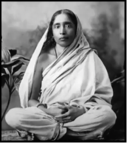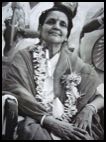Spiritual-Teaching.org
First Byte from Bhagavan, Taste and See 18th June, 1935 - Talk #55
Devotee: Can Advaita be realized by japa of holy names;
say Rama, Krishna, etc.?
Maharshi: Yes.
D.: Is it not a means of an inferior order?
M.: Have you been told to make japa or to discuss its order in the scheme of things?
Many who lived with Bhagavan during his physical sojourn on Earth said that he embodied the purest simplicity, truth and tradition. Although his guidance was a revelation of Universal Truth, he brought each of his followers to a unique experience of God in their journey toward the realization of the Self. His traditional approach embraced the teaching of the Rishis, including the use of the Name of God as a means of divine ascent. In the diaries of Muruganar Swami, called Padamalai, he says:
“Though Bhagavan rarely gave out mantras, when he did, he generally recommended “Siva, Siva’. Muruganar himself was given this mantra by Bhagavan, as were several other devotees including Annamalai Swami, the brother of Rangan (who was one of Bhagavan’s childhood friends), and also an unknown harijan.”
Muruganar continues, making special note of Bhagavan’s teachings regarding the use of mantras:
“Through grace, Padam (Muruganar’s epithet for Bhagavan) ensures that there is never any danger to those who remain in their heart, meditating ‘Sivaya Nama’.”
Although these disciples daily bathed in the spiritual effulgence of Bhagavan’s presence, through his instruction to make japa in meditation, they learned to invoke and taste the Divine Flavor of the Name of God. Taste and see!
Bytes of Wisdom From Bhagavan Ramana Maharshi
It is related (and the story is no less significant whether historically true or not) that after attaining Enlightenment the Buddha’s first impulse was to abide in the effulgence of Bliss without turning back to convey the incommunicable to mankind. Then he reflected,
“Some there are who are clear sighted and do not need my teachings, and some whose eyes are clouded with dust who will not heed it though given, but between these two there are also some with but little dust in their eyes, who can be helped to see;
And for the sake of these I will go back among mankind and teach.”
(For Those with Little Dust, Selected Writings of Arthur Osborne, p. 85)
This book is dedicated with respectful thanksgiving to Arthur Osborne, who in his life of discipleship to Sri Ramana Maharshi
sought to bring understanding for those “of little dust”.


